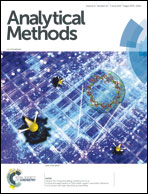Calibration transfer of flour NIR spectra between benchtop and portable instruments
Abstract
This work reports on the use of different strategies of calibration transfer to determine crude protein and fiber properties in samples of functional flours analyzed with benchtop (primary) and portable (secondary) NIR instruments. For this purpose, methods of direct standardization (DS) and reverse standardization (RS) were used on a different number of transfer samples. Calibration models based on the following regression strategies were evaluated: partial least squares using a full spectrum (PLSfull spectrum); PLS with significant regression coefficients selected by the Jack-Knife algorithm (PLS/JK) and multiple linear regression (MLR) with previous selection of variables by the successive projection algorithm (MLR/SPA). The performance of calibration models was assessed according to Root Mean Square Error of Prediction (RMSEP) values obtained in a prediction subset measured on a secondary instrument before and after standardization procedures. Before standardization, all the calibration models presented high RMSEP values for the prediction samples measured on the secondary instrument to determine both crude protein and fibers. After the direct standardization, a considerable decrease of the RMSEP values was observed in the PLSfull spectrum and MLR/SPA calibration models developed for crude protein determination. For fiber determination, the lowest RMSEP value was obtained using the PLSfull spectrum model with RS, although no statistically significant difference was found between the RMSEP values obtained for PLS/JK and MLR/SPA models.



 Please wait while we load your content...
Please wait while we load your content...